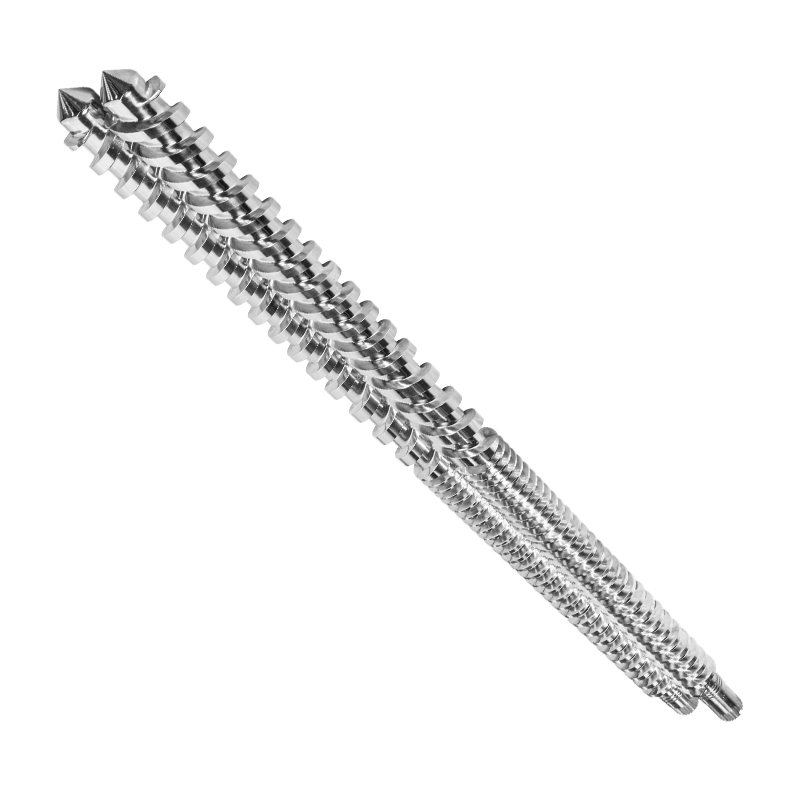We provide custom solutions to all our customers and offer complete technical advices that your company can take advantage of.
Screw and barrel selection plays a crucial role in optimizing extrusion processes and can significantly impact product quality. The screw and barrel are key components of an extruder, responsible for melting, mixing, and conveying the material through the extrusion system.
Melting and Mixing Efficiency: The design of the screw and barrel affects the melting and mixing efficiency of the material. The screw should have the appropriate flight depth, pitch, and compression ratio to achieve the desired melting and mixing characteristics. Efficient melting and mixing help ensure uniformity and homogeneity of the melted material, which translates into improved product quality. For example, in the plastic extrusion industry, selecting a screw with a specific compression ratio and flight depth can ensure efficient melting and mixing of additives in the polymer matrix. This results in uniform dispersion of colorants, fillers, or reinforcing agents, leading to consistent product color and improved mechanical properties.
Residence Time Control: The screw design also affects the residence time of the material inside the extruder. Residence time refers to the duration the material spends in the extruder from the feed hopper to the die. It is essential to control the residence time to avoid thermal degradation or over-processing of the material, which can negatively impact product properties. The screw and barrel configuration can be optimized to achieve the desired residence time and minimize any adverse effects. In the production of heat-sensitive materials like PVC (polyvinyl chloride), the selection of a screw and barrel with appropriate screw length and pitch can help control the residence time. This prevents excessive heating and degradation of the polymer, preserving its molecular weight and reducing the chances of discoloration or brittleness in the final product.
Pressure Build-up and Control: The screw geometry and barrel design influence the pressure build-up and control within the extruder. Proper pressure control is crucial to avoid issues like melt fracture, inconsistent dimensions, or surface defects in the extruded product. The choice of screw design, such as the use of barrier screws or venting, can help optimize pressure distribution and control, leading to improved product quality.In the extrusion of high-viscosity materials, such as silicone rubber, using a barrier screw design with mixing sections can optimize pressure build-up and distribution. This ensures thorough mixing of components and prevents pressure variations that could result in uneven curing, voids, or surface defects in the extruded silicone products.
Throughput and Cooling: The screw and barrel selection can impact the extrusion throughput rate, which is the amount of material processed per unit of time. The design should be optimized to achieve the desired throughput while maintaining proper cooling. Inadequate cooling can result in dimensional instability or warping of the product, affecting its quality. The screw design should allow efficient heat transfer and cooling to ensure consistent and controlled cooling of the extruded material. For instance, in the production of plastic pipes, selecting a screw and barrel combination with efficient heat transfer properties can improve cooling rates. This helps maintain the desired dimensional stability of the extruded pipes, preventing warping or distortion due to inadequate cooling, and ensuring consistent product quality.
Material Compatibility: Different materials have varying rheological properties, such as viscosity and shear sensitivity. The screw and barrel should be selected based on the specific material being extruded to ensure compatibility. The geometry, surface treatment, and material of construction should be chosen to minimize material degradation, shear heating, or excessive wear. Proper material compatibility helps maintain product quality and prolong the life of the screw and barrel. When extruding abrasive materials like glass-filled polymers, using screws with hardened surfaces or incorporating wear-resistant coatings on the barrel can extend the equipment's lifespan. This minimizes wear and degradation, ensuring consistent product quality and reducing downtime for maintenance.
Die Flow and Product Shape: The screw and barrel design influence the flow of the molten material through the die and the resulting product shape. The choice of screw profile, die design, and melt flow channel geometry affects factors like melt pressure, shear rate, and residence time distribution. Optimizing these parameters helps achieve the desired product dimensions, surface finish, and mechanical properties. In the extrusion of profiles, such as window frames or tubing, the selection of a specific screw and barrel design, combined with appropriate die geometry, influences the flow behavior of the molten material. For example, incorporating a barrier section in the screw design can improve pressure distribution, reducing the likelihood of flow marks or uneven wall thickness in the extruded profiles.
Barrelize is professional screw barrel manufacturer and supplier which manufacture single and twin screw and barrel for injection molding machine, extruder machine.

